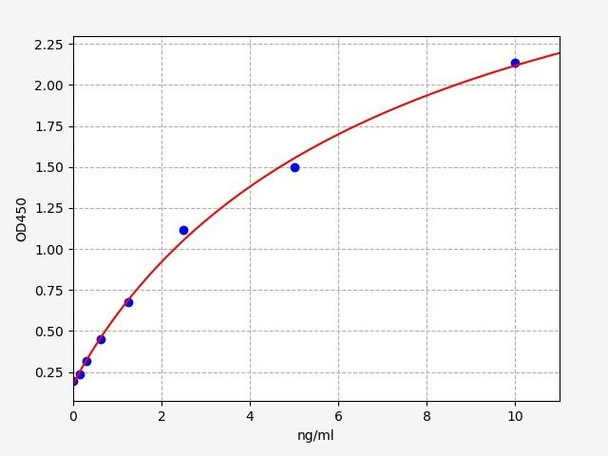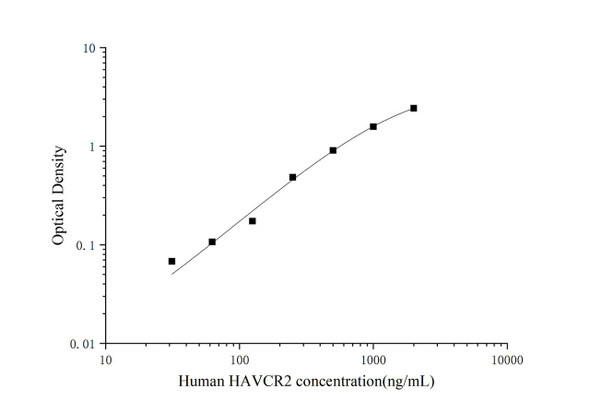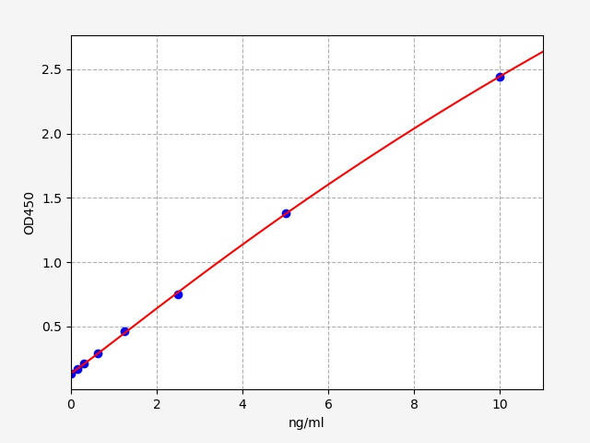HAVCR2 (Hepatitis A virus cellular receptor 2) is a Th1-specific cell surface protein belonging to the TIM family of proteins. HAVCR2 regulates macrophage activation, and inhibits Th1-mediated auto- and alloimmune responses, and promotes immunological tolerance. HAVCR2 is associated with diseases including Subcutaneous Panniculitis-Like T-Cell Lymphoma, and Panniculitis.
Description
Human HAVCR2 (Hepatitis A virus cellular receptor 2) ELISA Kit
Key Features
| Save Time | Pre-coated 96 well plate | |
| Quick Start | Kit includes all necessary reagents | |
| Publication Ready | Reproducible and reliable results |
Overview
| Product Name: | Human HAVCR2 (Hepatitis A virus cellular receptor 2) ELISA Kit |
| Product Code: | HUFI08163 |
| Size: | 96 Assays |
| Alias: | Hepatitis A virus cellular receptor 2 ELISA Kit, HAVcr-2 ELISA Kit, T-cell immunoglobulin and mucin domain-containing protein 3 ELISA Kit, TIMD-3 ELISA Kit, T-cell immunoglobulin mucin receptor 3 ELISA Kit, TIM-3 ELISA Kit, T-cell membrane protein 3 ELISA Kit, CD366 ELISA Kit, HAVCR2 ELISA Kit, TIM3 ELISA Kit, TIMD3 ELISA Kit |
| Detection Method: | Sandwich ELISA, Double Antibody |
| Application: | This immunoassay kit allows for the in vitro quantitative determination of Human HAVCR2 (Hepatitis A virus cellular receptor 2) concentrations in serum plasma and other biological fluids. |
| Sensitivity: | < 0.094ng/ml |
| Range: | 0.156-10ng/ml |
| Storage: | 4°C for 6 months |
| Note: | For Research Use Only |
Additional Information
| Recovery | Matrices listed below were spiked with certain level of Human HAVCR2 (Hepatitis A virus cellular receptor 2) and the recovery rates were calculated by comparing the measured value to the expected amount of Human HAVCR2 (Hepatitis A virus cellular receptor 2) in samples
| ||||||||||||||||||||
| Linearity | The linearity of the kit was assayed by testing samples spiked with appropriate concentration of Human HAVCR2 (Hepatitis A virus cellular receptor 2) and their serial dilutions. The results were demonstrated by the percentage of calculated concentration to the expected.
| ||||||||||||||||||||
| CV(%) | Intra-Assay: CV<8% |
Kit Components
| Component | Quantity | Storage |
| ELISA Microplate (Dismountable) | 8x12 strips | 4°C for 6 months |
| Lyophilized Standard | 2 | 4°C/ -20°C |
| Sample/Standard Dlution Buffer | 20ml | 4°C |
| Biotin-labeled Antibody (Concentrated) | 120ul | 4°C (Protection from light) |
| Antibody Dilution Buffer | 10ml | 4°C |
| HRP-Streptavidin Conjugate (SABC) | 120ul | 4°C (Protect from light) |
| SABC Dilution Buffer | 10ml | 4°C |
| TMB Substrate | 10ml | 4°C (Protection from light) |
| Stop Solution | 10ml | 4°C |
| Wash Buffer (25X) | 30ml | 4°C |
| Plate Sealer | 5 | - |
Other materials required:
- Microplate reader with 450 nm wavelength filter
- Multichannel Pipette, Pipette, microcentrifuge tubes and disposable pipette tips
- Incubator
- Deionized or distilled water
- Absorbent paper
- Buffer resevoir
Protein Information
| UniProt | |
| NCBI GenInfo Identifier | |
| NCBI Gene ID | |
| NCBI Summary | The protein encoded by this gene belongs to the immunoglobulin superfamily, and TIM family of proteins. CD4-positive T helper lymphocytes can be divided into types 1 (Th1) and 2 (Th2) on the basis of their cytokine secretion patterns. Th1 cells are involved in cell-mediated immunity to intracellular pathogens and delayed-type hypersensitivity reactions, whereas, Th2 cells are involved in the control of extracellular helminthic infections and the promotion of atopic and allergic diseases. This protein is a Th1-specific cell surface protein that regulates macrophage activation, and inhibits Th1-mediated auto- and alloimmune responses, and promotes immunological tolerance. [provided by RefSeq, Sep 2011] |
| UniProt Protein Details | Protein type: Receptor, misc.; Membrane protein, integral Chromosomal Location of Human Ortholog: 5q33.3 Cellular Component: integral to membrane Disease: Rheumatoid Arthritis |
Protocol
*Note: Protocols are specific to each batch/lot. For the exact instructions please follow the protocol included in your kit.
Before adding to wells, equilibrate the SABC working solution and TMB substrate for at least 30 min at 37°C. When diluting samples and reagents, they must be mixed completely and evenly. It is recommended to plot a standard curve for each test.
| Step | Procedure |
| 1. | Set standard, test sample and control (zero) wells on the pre-coated plate respectively, and then, record their positions. It is recommended to measure each standard and sample in duplicate. Wash plate 2 times before adding standard, sample and control (zero) wells! |
| 2. | Aliquot 0.1ml standard solutions into the standard wells. |
| 3. | Add 0.1 ml of Sample / Standard dilution buffer into the control (zero) well. |
| 4. | Add 0.1 ml of properly diluted sample ( Human serum, plasma, tissue homogenates and other biological fluids.) into test sample wells. |
| 5. | Seal the plate with a cover and incubate at 37 °C for 90 min. |
| 6. | Remove the cover and discard the plate content, clap the plate on the absorbent filter papers or other absorbent material. Do NOT let the wells completely dry at any time. Wash plate X2. |
| 7. | Add 0.1 ml of Biotin- detection antibody working solution into the above wells (standard, test sample & zero wells). Add the solution at the bottom of each well without touching the side wall. |
| 8. | Seal the plate with a cover and incubate at 37°C for 60 min. |
| 9. | Remove the cover, and wash plate 3 times with Wash buffer. Let wash buffer rest in wells for 1 min between each wash. |
| 10. | Add 0.1 ml of SABC working solution into each well, cover the plate and incubate at 37°C for 30 min. |
| 11. | Remove the cover and wash plate 5 times with Wash buffer, and each time let the wash buffer stay in the wells for 1-2 min. |
| 12. | Add 90 µl of TMB substrate into each well, cover the plate and incubate at 37°C in dark within 10-20 min. (Note: This incubation time is for reference use only, the optimal time should be determined by end user.) And the shades of blue can be seen in the first 3-4 wells (with most concentrated standard solutions), the other wells show no obvious color. |
| 13. | Add 50 µl of Stop solution into each well and mix thoroughly. The color changes into yellow immediately. |
| 14. | Read the O.D. absorbance at 450 nm in a microplate reader immediately after adding the stop solution. |
Sample Type
When carrying out an ELISA assay it is important to prepare your samples in order to achieve the best possible results. Below we have a list of procedures for the preparation of samples for different sample types.
| Sample Type | Protocol |
| Serum | If using serum separator tubes, allow samples to clot for 30 minutes at room temperature. Centrifuge for 10 minutes at 1,000x g. Collect the serum fraction and assay promptly or aliquot and store the samples at -80°C. Avoid multiple freeze-thaw cycles. If serum separator tubes are not being used, allow samples to clot overnight at 2-8°C. Centrifuge for 10 minutes at 1,000x g. Remove serum and assay promptly or aliquot and store the samples at -80°C. Avoid multiple freeze-thaw cycles. |
| Plasma | Collect plasma using EDTA or heparin as an anticoagulant. Centrifuge samples at 4°C for 15 mins at 1000 × g within 30 mins of collection. Collect the plasma fraction and assay promptly or aliquot and store the samples at -80°C. Avoid multiple freeze-thaw cycles. Note: Over haemolysed samples are not suitable for use with this kit. |
| Urine & Cerebrospinal Fluid | Collect the urine (mid-stream) in a sterile container, centrifuge for 20 mins at 2000-3000 rpm. Remove supernatant and assay immediately. If any precipitation is detected, repeat the centrifugation step. A similar protocol can be used for cerebrospinal fluid. |
| Cell culture supernatant | Collect the cell culture media by pipette, followed by centrifugation at 4°C for 20 mins at 1500 rpm. Collect the clear supernatant and assay immediately. |
| Cell lysates | Solubilize cells in lysis buffer and allow to sit on ice for 30 minutes. Centrifuge tubes at 14,000 x g for 5 minutes to remove insoluble material. Aliquot the supernatant into a new tube and discard the remaining whole cell extract. Quantify total protein concentration using a total protein assay. Assay immediately or aliquot and store at ≤ -20 °C. |
| Tissue homogenates | The preparation of tissue homogenates will vary depending upon tissue type. Rinse tissue with 1X PBS to remove excess blood & homogenize in 20ml of 1X PBS (including protease inhibitors) and store overnight at ≤ -20°C. Two freeze-thaw cycles are required to break the cell membranes. To further disrupt the cell membranes you can sonicate the samples. Centrifuge homogenates for 5 mins at 5000xg. Remove the supernatant and assay immediately or aliquot and store at -20°C or -80°C. |
| Tissue lysates | Rinse tissue with PBS, cut into 1-2 mm pieces, and homogenize with a tissue homogenizer in PBS. Add an equal volume of RIPA buffer containing protease inhibitors and lyse tissues at room temperature for 30 minutes with gentle agitation. Centrifuge to remove debris. Quantify total protein concentration using a total protein assay. Assay immediately or aliquot and store at ≤ -20 °C |
| Breast Milk | Collect milk samples and centrifuge at 10,000 x g for 60 min at 4°C. Aliquot the supernatant and assay. For long term use, store samples at -80°C. Minimize freeze/thaw cycles. |
HAVCR2 Background
Hepatitis A Virus
Hepatitis A virus (HAV) is a highly contagious pathogen that primarily affects the liver, causing a viral infection known as Hepatitis A. It is a member of the Picornaviridae family and is typically transmitted through the consumption of contaminated food or water, or through close contact with an infected individual. (HAV) is a virus that is primarily transmitted through the digestive system and replicates mainly in hepatocytes. After replicating in the liver, the virus is then excreted from the body through bile and ultimately expelled in feces. HAV infections can range from mild cases with no noticeable symptoms to severe illnesses that can lead to liver failure and even death, especially in older adults or individuals with pre-existing liver conditions.
HAVCR2
HAVCR2, also known as Hepatitis A Virus Cellular Receptor 2, is a gene that encodes a protein. It is associated with various diseases, including T-Cell Lymphoma, Subcutaneous Panniculitis-Like, and Hepatitis A. HAVCR2 is involved in several pathways related to immune system function, such as Cytokine Signaling and Interleukin-2 family signaling.
HAVCR2 Structure
HAVCR2, also known as TIM-3 (T-cell immunoglobulin and mucin domain-containing protein 3), is a transmembrane protein that consists of an extracellular domain, a transmembrane domain, and an intracellular domain. The extracellular domain of HAVCR2 contains an immunoglobulin variable domain (IgV) and a mucin-like domain. These domains are involved in protein-protein interactions, facilitating binding to ligands and signaling molecules. The transmembrane domain anchors the receptor in the cell membrane, while the intracellular domain plays a crucial role in signal transduction and cellular responses. The specific structural characteristics of HAVCR2 contribute to its function as a cell surface receptor, potentially influencing immune responses and interactions with various pathogens.
HAVCR2 Function
HAVCR2 is predominantly expressed on various immune cells, including T cells, dendritic cells, and macrophages. Its primary function is to regulate immune responses by binding to specific ligands, such as galectin-9, thereby modulating immune cell activation and differentiation. Additionally, HAVCR2 has been implicated in the regulation of T cell exhaustion, a state of dysfunction commonly observed during chronic viral infections. Understanding the function of HAVCR2 can provide valuable insights into the mechanisms of immune response against HAV and potentially aid in the development of therapeutic interventions.
HAVCR2 ELISA FAQs
What is the HAVCR2 ELISA Kit used for?
The HAVCR2 ELISA Kit is designed for the detection and quantification of Hepatitis A Virus Cellular Receptor 2 (HAVCR2) in biological samples. It allows researchers and healthcare professionals to investigate the levels of HAVCR2 protein in various samples, aiding in research studies, diagnostic applications, and therapeutic development related to immune responses, viral infections, and other relevant biological processes.
What are the advantages of using the HAVCR2 ELISA Kit?
The HAVCR2 ELISA Kit offers several advantages, including high sensitivity, accuracy, and reproducibility. It provides a user-friendly and reliable method to quantify HAVCR2 levels in biological specimens, allowing for precise measurements and robust data analysis.
What sample types are compatible with the HAVCR2 ELISA Kit?
The HAVCR2 ELISA Kit is compatible with various sample types, including serum, plasma, cell lysates, and tissue homogenates. It provides flexibility in sample selection, allowing researchers to analyze Fc epsilon RI levels in different biological matrices.
What are the storage requirements for the HAVCR2 ELISA Kit?
The HAVCR2 ELISA Kit components should be stored according to the instructions provided in the kit manual. Generally, it is recommended to store the kit components at the recommended temperature to ensure their stability and optimal performance.
What should I do if my assay results are not optimal?
If you encounter any issues or have suboptimal assay results, we recommend contacting our dedicated support team for assistance. They will be available to provide troubleshooting guidance, answer your questions, and ensure you achieve the best possible results with the HAVCR2 ELISA Kit.
Related Products

| Anti-TIM-3/HAVCR2 Antibody (CAB13443) | |
|---|---|
| Product Type | Antibody |
| Isotype | IgG |
| Antibody Type | Polyclonal Antibody |

| Anti-TIM-3/HAVCR2 Antibody (CAB13444) | |
|---|---|
| Product Type | Antibody |
| Isotype | IgG |
| Antibody Type | Polyclonal Antibody |

| Anti-TIM-3/HAVCR2 Antibody (CAB13445) | |
|---|---|
| Product Type | Antibody |
| Isotype | IgG |
| Antibody Type | Polycloncal Antibody |







